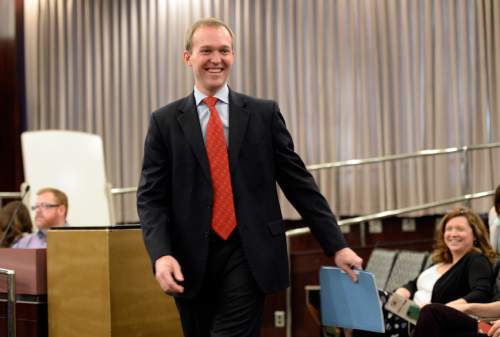This is an archived article that was published on sltrib.com in 2015, and information in the article may be outdated. It is provided only for personal research purposes and may not be reprinted.
Salt Lake County officials think they have found a way to preserve the unincorporated area's present boundaries — protecting its tax base and service-delivery system — while letting individual communities become cities if they choose.
Developed over the past year in consultation with community council leaders, Mayor Ben McAdams' plan begins with the creation of a service district encompassing all of the county outside of existing city boundaries.
This district really won't be anything new. Called the Greater Salt Lake Metropolitan Services District, it would provide all of the services delivered by the county's Office of Township Services in unincorporated areas through its municipal-services fund.
But creating the district is necessary, technically, to support the establishment of a "metropolitan township," McAdams says, in much the same way that funding districts were formed for the Unified Police Department and the Unified Fire Authority when those public-safety agencies branched off from the county.
"It provides clarity about who will be providing those services, which is what the communities have asked us to do for a while," added Deputy County Mayor Nichole Dunn.
The County Council tentatively has endorsed the district concept and has scheduled two public hearings — Feb. 10 in Kearns, Feb. 17 in Millcreek — before finalizing its approval.
"Once those hearings are held, [the concept] comes back to the County Council to add structure to the bones, to figure out what this entity looks like," said Deputy District Attorney Gavin Anderson.
Having a district would set the stage for part two of McAdams' plan to end 30-plus years of boundary battles among local governments in the Salt Lake Valley.
He is drafting a Community Preservation Act, to be carried by Sen. Karen Mayne, D-West Valley City. If approved by the Legislature, it would send unincorporated-area residents to the polls in November to answer a question: Do you want your township, or unincorporated island, to become part of a) a metropolitan township, or b) a city?
The results of the multiple decisions that night would take shape in 2017.
Before then, each township that opts to join the metropolitan township will have another election in 2016 to select a five-member council, whose leader also will sit on a broader board that will govern the whole service district. This ensures, McAdams said, that unincorporated area residents will have a direct voice over the district's delivery of three main types of municipal services:
• Road construction and maintenance, installation of curbs, gutters and sidewalks, streetlights, traffic-control lights and signs, striping and snow removal.
• Animal-control services.
• Local storm-drain construction and maintenance.
If a community such as Millcreek voted to become a city, the leaders it selects in 2016 elections would have six months to decide whether to stay with the service district for these municipal services, to deliver them on their own or to find other providers.
"We made it so that people can choose to become a city and to stay in the service district at the same time," Dunn said. "The one thing we've heard across the board is that people don't want their services to change."
Incorporation would give a township more control over local planning and zoning matters and the right to enact locally important ordinances, McAdams said. On the other hand, becoming a city would end access to sales taxes paid by the unincorporated area's biggest taxpayer, Kennecott Copper.
"The intent of the Community Preservation Act is to provide local control," Dunn explained, "while still maintaining the cost effectiveness of collaborative, regional-service provision."
This concept evolved after McAdams obtained legislative approval last session to freeze the six townships' boundaries for a year while the county and local groups searched for a solution without further erosion of the unincorporated county's tax base by annexations and incorporations.
While individual community councils have not voted on the concept, it has the support of their umbrella organization, the Association of Community Councils Together (ACCT).
"There's been a lot of discussion on this, and this resolution looks really good," said Ron Faerber, ACCT's secretary and chairman of the Sandy Hills Community Council in the southeastern county. "There was some concern about breaking up services. Residents like county services. People like the economies of scale to keep costs low. This model does that for folks in the unincorporated area."
Added Janet Geyser of the Mount Olympus Community Council in Millcreek: "It's exciting to see we're finally getting to this point."
Nancy Carlson-Gotts of the East Millcreek Community Council also is supportive, but wants to make sure the Community Preservation Act shifts management of the service district from the County Council to the board of township representatives.
The plan currently calls for that handoff to occur in 2017, with the County Council overseeing the service district until then.
Twitter: @sltribmikeg —
Public hearings
The Salt Lake County Council will accept public comment on the proposed creation of a Greater Salt Lake Metropolitan Services District:
Feb. 10 • West Kearns Elementary, 4900 S. 4620 West.
Feb. 17 • the Sons of Utah Pioneers building, 3301 E. Louise Ave. (2920 South).
Both start at 7 p.m.









